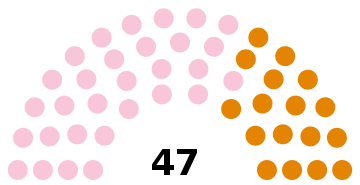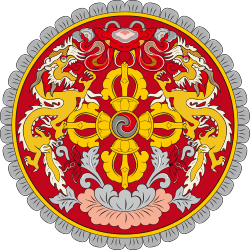National Assembly (Bhutan)
The National Assembly is the elected lower house of Bhutan's new bicameral Parliament which also comprises the Druk Gyalpo (Dragon King) and the National Council. It is the more powerful house.
National Assembly གི་རྒྱལ་ཡོངས་ཚོགས་འདུ་ Gyelyong Tshogdu | |
|---|---|
| Type | |
| Type | |
| Leadership | |
Speaker | |
Deputy Speaker | |
Leader of the House | |
Leader of the Opposition | |
| Structure | |
| Seats | 47 |
 | |
Political groups | Government (30)
Opposition (17)
|
| Elections | |
| Round 1: Party-only first-past-the-post Round 2: Two-party first-past-the-post | |
Last election | 15 September 2018 and 18 October 2018 |
| Meeting place | |
| Gyelyong Tshokhang, Thimphu | |
| Website | |
| Official Website of the National Assembly of Bhutan | |
 |
|---|
| This article is part of a series on the politics and government of Bhutan |
|
Monarchy |
|
Government |
Current National Assembly
The current National Assembly has 47 members, first elected in the inaugural general election on March 24, 2008. Jigme Thinley's Druk Phuensum Tshogpa (DPT) Party won a landslide victory, securing 45 seats. The People's Democratic Party (PDP) won the other two,[1] but its leader, Sangay Ngedup, lost the election in his constituency.[2]
Under the 2008 Constitution, Article 12, section 1, the National Assembly consists of a maximum of 55 members directly elected by the citizens of constituencies within each Dzongkhag (District).[3] Under this single-winner voting system, each constituency is represented by a single National Assembly member; each of the 20 Dzongkhags must be represented by between 2–7 members. Constituencies are reapportioned every 10 years (Art. 12, § 2).[3] The National Assembly meets at least twice a year (Art. 12, § 5), and elects a Speaker and Deputy Speaker from among its members (Art. 12, § 3). Members and candidates are allowed to hold political party affiliation.
The 2013 National Assembly election resulted in large increase in percentage of PDP members, who will hold 32 seats to the DPT's 15 when the new assembly convenes.[4]
History
The National Assembly was originally decreed in 1953 by King Jigme Dorji Wangchuck. The National Assembly began as a unicameral parliament within the King's framework for democratization. In 1971, King Jigme Dorji empowered the National Assembly to remove him or any of his successors with a two-thirds majority. The procedure for abdication remains a part of Bhutan's Constitution of 2008, with the addition of a three-fourth majority in a joint sitting of Parliament (i.e., including the National Council) to confirm the involuntary abdication as well as a national referendum to finalize it.[3] (Art. 2)
Electoral system
The 47 members of the National Assembly are elected from single-member constituencies. Primary elections are held in which voters cast votes for parties. The top two parties are then able to field candidates in the main round of voting, in which members are elected using first-past-the-post voting.[5]
Speakers
Complete list of Speakers of the National Assembly.[6]
| Name | Entered Office | Left Office |
|---|---|---|
| Dasho Kesang Dawa | 1953 | 1955 |
| Dasho Thinley Dorji | 1956 | 1963 |
| Dasho Tamji Jagar | 1964 | 1965 |
| Nidup Yanglop | 1966 | 1968 |
| Dasho Kesang Dawa | 1969 | 1971 |
| Dasho Shingkhar Lam | 1971 | 1974 |
| Nidup Yanglop | 1974 | 1977 |
| Dasho Tamji Jagar | 1977 | 1988 |
| Lyonpo Sangye Penjor | 1988 | 1989 |
| Dasho Passang Dorji | 1989 | 1997 |
| Lyonpo Kinzang Dorji | 1997 | 2000 |
| Dasho Ugyen Dorji | 2000 | 2007 |
| Lyonpo Jigme Tshultim | 2008 | 2013 |
| Lyonpo Jigme Zangpo | 2013 | 2018 |
| Lyonpo Wangchuk Namgyel | 2018 | Present |
Constituencies
%2C_administrative_divisions_-_en_-_monochrome.svg.png)
The National Assembly, the lower of the Parliament of Bhutan, consists Members of Parliament (MPs). Each MP represents a single geographic constituency.[7] Currently, there are 47 National Assembly constituencies.[8][9]
National Assembly constituencies are distributed among the dzongkhags[upper-alpha 1] in proportion to their registered voter population as recommended by the Delimitation Commission, provided that "no Dzongkhag shall have less than two more than seven National Assembly constituencies."[7]
Gelegphu (NA1301) constituency has the highest number of registered voter population with 16,283 registered voters; Khatoed_Laya (NA0402) constituency has the lowest number of registered voter population with 966 registered voters.
Out of the 20 dzongkhags of Bhutan, Trashigang, with five constituencies, has the highest number of National Assembly constituencies. Samtse, with four constituencies, has the second highest number of National Assembly constituencies. Mongar and Pema Gatshel, with three constituencies each, share the third highest position. All of the other 16 dzongkhags have two constituencies each.
The table below lists the 47 National Assembly constituencies with the name of the dzongkhag they are in, the number of constituent gewogs,[upper-alpha 2] and the number of registered voters.
| Code | Name | Dzongkhag | Number of Gewogs |
Registered voter population[upper-alpha 3] |
|---|---|---|---|---|
| NA0101 | Chhoekhor_Tang | Bumthang | 2 | 5721 |
| NA0102 | Chhumig_Ura | Bumthang | 2 | 3498 |
| NA0201 | Bongo_Chapchha | Chhukha[upper-alpha 4] | 5 | 13512 |
| NA0202 | Phuentshogling | Chhukha | 6 | 10228 |
| NA0301 | Drukjeygang_ Tseza | Dagana | 7 | 11521 |
| NA0302 | Lhamoi Dzingkha _Tashiding | Dagana | 7 | 11327 |
| NA0401 | Khamaed_Lunana | Gasa | 2 | 968 |
| NA0402 | Khatoed_Laya | Gasa | 2 | 966 |
| NA0501 | Bji_Kar-tshog_Uesu | Haa | 3 | 3982 |
| NA0502 | Sangbaykha | Haa | 3 | 3361 |
| NA0601 | Gangzur_Minjey | Lhuentse[upper-alpha 5] | 4 | 7717 |
| NA0602 | Maenbi_Tsaenkhar | Lhuentse | 4 | 7644 |
| NA0701 | Dramedtse_Ngatshang | Mongar[upper-alpha 6] | 7 | 12600 |
| NA0702 | Kengkhar_Weringla | Mongar | 5 | 10254 |
| NA0703 | Monggar | Mongar | 5 | 10008 |
| NA0801 | Dokar_Sharpa | Paro | 4 | 8209 |
| NA0802 | Lamgong_Wangchang | Paro | 6 | 9512 |
| NA0901 | Khar_Yurung | Pema Gatshel[upper-alpha 7] | 5 | 9032 |
| NA0902 | Nanong_Shumar | Pema Gatshel | 3 | 8809 |
| NA0903 | Nganglam | Pema Gatshel | 3 | 6662 |
| NA1001 | Kabisa_Talog | Punakha | 6 | 9293 |
| NA1002 | Lingmukha_Toedwang | Punakha | 5 | 6475 |
| NA1101 | Dewathang_Gomdar | Samdrup Jongkhar[upper-alpha 8] | 5 | 13429 |
| NA1102 | Jomotsangkha_Martshala | Samdrup Jongkhar | 6 | 10153 |
| NA1201 | Dophuchen_Tading | Samtse | 4 | 12536 |
| NA1202 | Phuentshogpelri_Samtse | Samtse | 3 | 10229 |
| NA1203 | Tashichhoeling | Samtse | 4 | 12376 |
| NA1204 | Ugyentse_Yoeseltse | Samtse | 4 | 9186 |
| NA1301 | Gelegphu | Sarpang | 7 | 16283 |
| NA1302 | Shompangkha | Sarpang | 5 | 12451 |
| NA1401 | North Thimphu Thromde_Kawang_Lingzhi_Naro_Soe | Thimphu | 4 | 5446 |
| NA1402 | South Thimphu Thromde_Chang_Darkarla_Ge-nyen_Maedwang | Thimphu | 4 | 8124 |
| NA1501 | Bartsham_Shongphu | Trashigang | 4 | 10688 |
| NA1502 | Kanglung_Samkhar_Udzorong | Trashigang | 3 | 10311 |
| NA1503 | Radhi_Sagteng | Trashigang | 4 | 9155 |
| NA1504 | Thrimshing | Trashigang | 2 | 6550 |
| NA1505 | Wamrong | Trashigang | 2 | 7821 |
| NA1601 | Boomdeling_Jamkhar | Trashi Yangtse[upper-alpha 9] | 4 | 8793 |
| NA1602 | Khamdang_Ramjar | Trashi Yangtse | 4 | 8740 |
| NA1701 | Draagteng_Langthil | Trongsa | 3 | 5558 |
| NA1702 | Nubi_Tangsibji | Trongsa | 2 | 4163 |
| NA1801 | Kilkhorthang_Mendrelgang | Tsirang | 6 | 11080 |
| NA1802 | Sergithang_Tsirangtoed | Tsirang | 6 | 10527 |
| NA1901 | Athang_Thedtsho | Wangdue Phodrang[upper-alpha 10] | 8 | 9249 |
| NA1902 | Nyishog_Saephu | Wangdue Phodrang | 7 | 9635 |
| NA2001 | Bardo_Trong | Zhemgang | 4 | 10157 |
| NA2002 | Panbang | Zhemgang | 4 | 7211 |
See also
Notes
- The word "dzongkhag" translates to "district". In English uses, specific Dzongkha words, including the word "dzongkhag", are italicised and only translated the first time they are used.[10]
- The word "gewog" translates to "county".[11] In English uses, specific Dzongkha words, including the word "gewog", are italicised and only translated the first time they are used.[10]
- As of 2017-05-08
- Also spelled as "Chukha"
- Also spelled as "Lhuntse"
- Also spelled as "Monggar"
- Also spelled as "Pemagatshel"
- Also spelled as "Samdrupjongkhar"
- Also spelled as"Trashiyangste"
- Also spelled as "Wangduephodrang"
References
- Majumdar, Bappa (March 27, 2008). "CORRECTED: Bhutan corrects poll results, opposition shrinks". Reuters. Retrieved 2009-05-10.
- "Bhutan votes for status quo" Archived 2011-04-29 at the Wayback Machine, France 24, March 24, 2008
- "Constitution of the Kingdom of Bhutan (English)" (PDF). Government of Bhutan. 2008-07-18. Archived from the original (PDF) on 2011-07-06. Retrieved 2010-10-13.
- "Bhutan's Election Commission completes polls process, hands over MP list to King". DNA India. 2013-07-14. Retrieved 14 July 2013.
- Electoral system IPU
- Past Speakers National Assembly of Bhutan.
- "Election Act of the Kingdom of Bhutan 2008" (PDF). Government of Bhutan. 2008. Archived (PDF) from the original on 2018-09-21. Retrieved 2019-05-25.
- "Final Delimitation Order For The National Assembly Constituencies Of The Kingdom Of Bhutan, 2017" (PDF). Election Commission of Bhutan. 2017-12-26. Archived from the original (PDF) on 2019-06-15.
- "Constituency List". National Assembly of Bhutan. Archived from the original on 2019-04-02. Retrieved 2019-05-31.
- J. Schuelka, Matthew; W. Maxwell, Tom, eds. (2016). Education in Bhutan: Culture, Schooling and Gross National Happiness (PDF). Education in the Asia-Pacific Region: Issues, Concerns and Prospects. 36. Springer. pp. 2–3. doi:10.1007/978-981-10-1649-3. ISBN 978-981-10-1647-9. ISSN 1573-5397. LCCN 2016948217. Archived from the original (PDF) on 2019-06-09. Retrieved 2019-06-09.
- "The Constitution of the Kingdom of Bhutan" (PDF). Government of Bhutan. 2008. p. 64. Archived (PDF) from the original on 2019-04-29. Retrieved 2019-06-01.
External links
- "Official website of the National Assembly of Bhutan". Retrieved 2008-04-16.